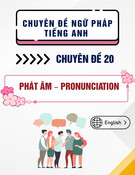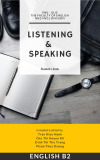
TẠP CHÍ KHOA HỌC - ĐẠI HỌC ĐỒNG NAI, SỐ 32 - 2024 ISSN 2354-1482
15
IMPROVING EFL LEARNERS’ LISTENING SKILL THROUGH
ENGLISH CARTOONS: AN EXPERIMENTAL STUDY
AT PHAN THIET UNIVERSITY, VIETNAM
Tran Thi Quynh Le
Phan Thiet University
Email: ttqle@upt.edu.vn
(Received: 21/8/2024, Revised: 30/8/2024, Accepted for publication: 13/9/2024)
ABSTRACT
By the aim to enhance the listening skills of EFL freshmen, an experiment was
conducted using cartoons with thirty-five first-year students in an experimental
group, compared to a control group, through pre-tests and post-tests. The
intervention took place over five weeks during the first semester of the 2022-2023
school year, utilizing ten cartoons as research tools. Additionally, classroom
observations focusing on five key content areas were carried out to assess
participants’ reactions to this method. The post-test results indicated that cartoons
were an effective teaching aid, with the experimental group's listening scores
improving by 31 percent, significantly higher than the control group's 12.5 percent
increase. The findings revealed a clear difference between the two groups'
performance, confirming that cartoons are a valuable tool for improving EFL
learners’ listening comprehension.
Keywords: Cartoons, EFL learners, listening skill, treatment
1. Introduction
Among the four language skills,
listening is often the most difficult for
learners. Rivers (1986, p. 15) points out
that listening occupies a substantial part
of an adult's time, estimating that adults
spend 45% of their communication time
listening, 30% speaking, 16% reading,
and just 9% writing. Furthermore,
listening is the first skill developed
when learning a foreign language. In
other words, before someone can
understand and produce speech, they
must first perceive sounds, words, and
speech patterns. Therefore, listening is
the foundational skill in language
acquisition.
The purpose of teaching listening is
to enhance students' listening abilities.
The primary objective is to prepare
students for global competition by
improving their understanding and
awareness of the fundamental role and
significance of the English language.
Another goal of English teaching is to
deepen students' comprehension of the
relationship between language and
culture (Rahayu & Permatasari, 2021).
English language skills are crucial for
global communication, as English has
become a key medium for accessing
valuable information and resources
across various platforms, including
print and electronic media. This aligns
with the goals of Education for
Sustainable Development (ESD) as
outlined in the SDGs and MDGs
(Hermann in Syakur, 2020). It is a
response to addressing global
challenges through character education

TẠP CHÍ KHOA HỌC - ĐẠI HỌC ĐỒNG NAI, SỐ 32 - 2024 ISSN 2354-1482
16
and national awareness. Streaming
cartoon videos is considered one of the
most effective and practical ways to
improve listening skills. Using
animated films helps students retain the
lesson and keeps them engaged and
motivated during the class.
In practice, the use of cartoon
movies in promoting listening skills
deserves more consideration. The
potential of these cartoon videos lies in
their effectiveness. Instead of simply
practicing listening, students can use
this method and observe its impact.
Focusing on the challenges faced by
EFL students at Phan Thiet University,
the researcher aims to contribute a
visual technique that can improve their
listening comprehension. Moreover, the
lack of previous research on this
specific topic highlights a gap that this
study seeks to address. Therefore, the
research titled “Boosting EFL Students’
Listening Skills through English
Cartoons: An Experiment at Phan Thiet
University” is seen as a novel and
valuable solution for an important
educational issue. Based on theoretical
foundations and the study’s context, the
research aims to answer the question:
“How can English cartoons enhance
EFL students’ listening skills?”.
According to Rahmawati (2010),
listening requires effort because it
involves recognizing and understanding
what others are saying. This process
includes being attentive to the speaker's
vocabulary, grammar, and accent.
Listening is considered an active
process in which listeners extract and
interpret information from both visual
and auditory signals to clarify the
message and situation being
communicated by the speaker. Active
listening involves gathering information
through auditory and visual cues and
connecting it with prior knowledge
(Rubin and Rubin, 1995). The term
“select” means that listeners focus on
specific parts of the incoming
information to make sense of it, while
“interpretation” refers to the process of
combining prior knowledge with new
information to understand the input and
determine the speaker's intent.
Despite previously being
considered a passive skill, listening is,
in fact, an active process. Celce-Murcia
(2001) highlights Anderson and Lynch's
challenge to the notion of listening as a
passive act, rejecting the idea of the
listener as a “tape recorder.” They
argued that this perspective falls short
of explaining how listeners derive
meaning from spoken texts, which
depends on their personal listening
objectives and prior knowledge. In this
context, listening comprehension
involves the integration of both non-
linguistic skills (such as interpreting the
speaker's intentions and using social
skills like providing feedback and
addressing misunderstandings) and
linguistic skills (such as recognizing
words, segmenting speech, and
processing discourse in terms of
coherence, logic, and relevant
underlying schemas) (Celce-Murcia,
2001, p. 72).
Listening is a complex process that
involves several stages for a full
understanding of spoken language.

TẠP CHÍ KHOA HỌC - ĐẠI HỌC ĐỒNG NAI, SỐ 32 - 2024 ISSN 2354-1482
17
Petty and Jensen (1981, p.181) suggest
three key steps in the listening process.
First, in the “listening to” stage,
listeners perceive words and phrases as
sounds. Second, comprehension occurs
when listeners understand these words
and sentences within the context they
are used. Finally, in the "responding"
stage, listeners react to what they have
heard (Petty & Jensen, 1981, p.181).
The term, derived from the Latin
word meaning “between,” has been used
to refer to anything that transmits
information. Heinich, as cited in
Daryanto (2010, p. 4), explains that
media acts as a bridge or intermediary in
communication between the speaker and
the listener. Therefore, media serves as a
mediator between the communicator and
the communicant. Arsyad (2011, p. 4)
adds that multimedia is a tool that
delivers or conveys educational
messages. Effectively incorporating
media is essential for stimulating
students' natural responses, and its use
can assist teachers in achieving their
instructional goals.
According to Arsyad (2009, p. 49),
videos can be used to depict object
movement with realistic or natural
sound. By combining live images with
audio, videos become a dynamic and
engaging tool. Sherman (2003, p. 1)
argues that video contextualizes
language learning by bringing elements
of real life into the educational setting.
This form of communication is
designed for documentation, education,
and entertainment. Videos can convey
information, clarify complex processes
and ideas, and, most importantly, either
shorten or extend the duration of the
teaching and learning process.
Cartoons are likely the most well-
known and popular form of visual
media. They are drawings that feature
exaggerated caricatures of real people
and events, often created with simple
lines. Cartoons can be found in various
print media, such as newspapers,
magazines, and textbooks. They can
either be comic strips aimed at
entertainment or illustrations intended
to convey important social or political
messages. The skill of the cartoonist
lies in humor and satire (Heinich, 1996,
p.118). Careful consideration is
necessary when selecting media for
educational purposes to ensure effective
results. Based on these criteria, the
investigator concludes that cartoons are
humorous because they tell stories
about individuals, groups, or situations.
The primary function of video is to
display images on a screen, similar to
television. Heinich (1996) also
mentioned other media such as
interactive video, video games,
videocassettes, and videodiscs.
Educators must thoroughly prepare the
use of instructional media in the
classroom. Cahyaningrum (2010)
references Sand (1956, p. 353-355) and
Brown et al. (1977), who suggested
several methods for using video or
audiovisual media in teaching English
listening skills.
When using animated videos in the
classroom, Cakir (2006) emphasizes
that teachers should follow a few
practical strategies. These include: (1)
Active viewing, where the teacher plays

TẠP CHÍ KHOA HỌC - ĐẠI HỌC ĐỒNG NAI, SỐ 32 - 2024 ISSN 2354-1482
18
the video and allows students to watch
it fully, helping the teacher assess the
students' understanding of the content;
(2) Freeze framing and prediction,
where the teacher pauses the video to
focus on characters' reactions, body
language, emotions, and facial
expressions. This helps students learn
which expressions are appropriate in
English communication; (3) Silent
viewing, where the video is played
without sound, and students are asked
to infer what the characters are
discussing. This activity encourages
students to remember the dialogue.
Additionally, in the sound-on and
vision-off activity, students only hear
the dialogue without seeing the visuals,
requiring them to focus on the spoken
words. These strategies clearly
demonstrate the value and benefits of
incorporating visual aids in teaching
receptive skills, offering excellent
opportunities for students to enhance
their listening comprehension.
2. Methodology
2.1. Research design
The quantitative approach was used
to analyze the raw data in the study, as
reflected in the mean scores from both
the pre-tests and post-tests. SPSS
software was selected to process the
data and produce the results after a 5-
week experimental period.
To determine the differences
between the two groups after the
training, identical pre-tests and post-
tests were designed, each lasting 10
minutes and consisting of 20 questions.
Both groups answered these questions
after listening to an eight-minute audio.
The tests included a variety of listening
tasks, featuring three types of exercises:
multiple choice, cloze tests, and one-
two-three-word completion.
Additionally, the tests aimed to assess
changes in the EFL learners' listening
levels before and after watching
cartoons. The teacher-researcher was
responsible for teaching listening skills
to the experimental group using ten
cartoons, while the control group
followed traditional listening instruction
using a standard textbook.
For the control group, the five-week
pronunciation lesson plan was prepared
by the teacher according to the textbook
Solutions (new edition) by Tim Falla,
Paul A Davies Oxford University Press.
Lessons 1, 3 and 5 were four out of
eight lessons chosen by the researcher-
teacher for experimental period, each
class were from 15 to 18 minutes.
However, the distribution of knowledge
about pronunciation elements in the
book as well as in these 3 lessons was
not balanced and complete. This
required the experimental teacher to
think so that the controlled group was
arranged to teach a reasonable listening
teaching program and balanced in time
compared to the experimental group.
Regarding teaching methods, the
lecturer applies conventional teaching
techniques, students follow what the
teacher instructed.
2.2. Sample and sampling procedures
Out of 278 sophomores studying
English as a foreign language (EFL) in
the Faculty of Foreign Languages, 70
sophomores from various majors were
randomly selected as the research

TẠP CHÍ KHOA HỌC - ĐẠI HỌC ĐỒNG NAI, SỐ 32 - 2024 ISSN 2354-1482
19
sample. These participants shared
similar listening levels and
backgrounds. The experimental group
consisted of 35 EFL students, with the
remaining participants assigned to the
control group.
Research instruments
English cartoons
By the purpose to implement visual
tools to assist listening teaching, ten
English cartoons were chosen as the
first research instrument like Martha
Speak, Adventure Time, Finding Nemo,
Word Girl, Doki, Postcards from
Buster, The Simpsons, WordWorld,
Inspector Gadget, Teen Titans Go!.
used after pre-test completion and
before post-test finished. The following
procedures are taken in this research to
analyses the collected data. It was
conducted upon the procedure as
following:
Step 1: Asking students from both
groups complete a pre-test.
Step 2: Analyzing pre-tests’ scores.
Step 3: Performing teaching
experimental teaching listening by
cartoons on the experimental group,
teaching usual listening part following the
textbook.
Step 4: Giving the students a post-
test.
Step 5: Analyzing post-tests’ marks
using t-test for dependent group.
Step 6: Interpreting the research
results of the t-test to reveal the findings.
The experimental data will be
analyzed and compared using the
ANOVA algorithm in SPSS software to
assess how the two groups of students
perceive and pronounce elisions
differently before and after the trial. If
the Sig. (2-tailed) value is greater than
0.05, it indicates no significant
difference between the post-experiment
and initial results. Conversely, if the
Sig. (2-tailed) value is less than 0.05, it
suggests that the elision pronunciation
results vary significantly between the
two groups before and after the
experiment.
3. Results and discussion
3.1. Experimental results
In order to address the research
question, “How does watching English
cartoons improve EFL learners'
listening skills?”, pre-test and post-test
results were analyzed and compared to
highlight the differences between the
two groups before and after the
experiment. This comparison also
helped to assess the level of
improvement in students' pronunciation.
The pre-test results are presented in the
table 1.
Table 1: Proportion of correct answers for the experimental group and the
controlled group from the results of post-test
Experimental group
Controlled group
PRE-TEST
8.3/20 correct items (41.5%)
8.7/20 correct items
(43.5%)
POSTTEST
14.5/20 correct items (72.5%)
11.2/20 correct items
(56%)












![Đề cương môn Tiếng Anh 1 [Chuẩn Nhất/Mới Nhất]](https://cdn.tailieu.vn/images/document/thumbnail/2025/20251130/cubabep141@gmail.com/135x160/51711764555685.jpg)










![Mẫu thư Tiếng Anh: Tài liệu [Mô tả chi tiết hơn về loại tài liệu hoặc mục đích sử dụng]](https://cdn.tailieu.vn/images/document/thumbnail/2025/20250814/vinhsannguyenphuc@gmail.com/135x160/71321755225259.jpg)


